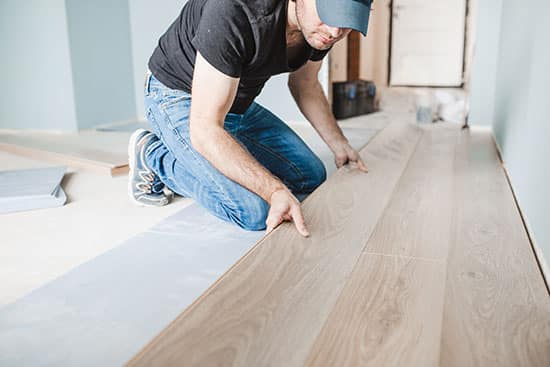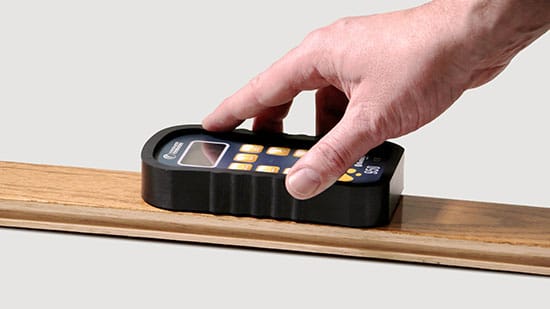How Much Does Flooring Installation Cost?

The cost of labor for new flooring varies based on several factors such as the type of material, how much labor is involved, and how many workers are needed.
If you’ve ever remodeled a space—either as a homeowner, contractor, or flooring installer—then you know the difference new floors make.
New floors can take a space from dated to fresh, from cool and unwelcoming to warm and homey. Plus, with proper care, new flooring can last for many years.
But keep in mind that new floors aren’t an impulse decision. In fact, they are a rather big investment. Depending on the flooring, square footage, and other factors, costs can vary from $1,500 to $10,000 or more.
That’s why, in this post, we’ll be answering this crucial question: how much does flooring installation cost? To do that, we’ll talk about all these important points:
- Factors that impact flooring cost
- How to calculate the cost of flooring installation
- How to reduce flooring installation costs (without sacrificing quality)
- Costs of different types of flooring installation
- Benefits of new flooring
- How to protect your new flooring from moisture issues
Let’s get started by looking at the factors that impact flooring installation costs.
**Note: Prices can change, so be sure to compare the prices in this article with current market prices.**
Factors That Impact Flooring Costs
Many different factors impact flooring prices, including but not limited to:
- Cost of materials and the type of flooring
- Floor size
- Labor costs and location
- Subfloor preparation and repairs
- Additional features
Cost of Materials and the Type of Flooring
The cost of materials and the type of flooring you choose are probably the most obvious factors that impact flooring costs.
Installing hardwood flooring is going to be more expensive than installing laminate flooring, simply because the type of flooring is more expensive to buy.
Different types of flooring have to be installed differently, too. Some may be more labor-intensive. Laying tile requires more time and more materials than tongue-and-groove flooring.
Flooring installers may also have to remove the existing flooring, which is an additional cost.
Floor Size
The size of the space that needs new flooring is a huge determinant of installation costs. Naturally, retiling a small bathroom is going to cost far less than putting new tiles down in a kitchen space or master bathroom.
But did you know the shape of the space also affects the cost?
Rooms that have a complex layout—like tight corners or spots that are difficult to access—can increase labor costs as well.
Labor Costs and Location
Usually, labor costs will vary between $0.60 and $4.00 per square foot, making this another crucial factor to consider.1
Labor costs will vary based on the type of material, how much labor is involved, and how many workers are needed. Usually, the larger the space, the more people need to be hired, and the more you can expect to pay for labor.
Labor costs will also increase if the team needs to travel to get to the installation location. And this cost (along with most of the factors) will increase depending on where the installation is located. For example, installing flooring in Hawaii or California is going to cost more than installing it in Alabama or Mississippi.
Subfloor Preparation and Repairs
If the flooring is being installed in a new build, a subfloor must be installed prior to flooring installation. Different types of subfloors also require different materials and labor. A concrete subfloor is going to require more labor and care than a wood subfloor.
If the subfloor has already been installed, it’s important to note the quality and state of the subfloor. For both wood and concrete subfloors, knowing their moisture condition is essential to the success of the flooring being installed over them. Testing the subfloor for moisture and repairing or addressing any problems may increase the timeline and labor costs.
Additional Features
Flooring installation costs don’t just include the flooring. Different features, such as baseboards, trims, or transitions, can also increase costs.
Now that we have an idea of the factors that impact the cost of flooring installation, let’s look at some ways you can calculate that cost.
How to Calculate the Cost of Flooring Installation
When you calculate the cost of a flooring installation, you’ll have to consider the factors we just talked about. However, you can begin by calculating the cost of the flooring itself and then go from there.
First off, you need to figure out the space in which the new flooring will be installed. Going room by room, measure the length and width of the floor in feet. You can multiply these together to get the area of each room in square feet. For example, a room that is 30 feet long and 30 feet wide is 900 square feet. Do this for each room, and then add up the square footage.
After you get the total square footage, multiply that square footage by the cost of material per square foot. For example, if the hardwood flooring you want to install costs $7 per square foot, and you have a 400-square-foot room, then the estimated cost of flooring for that room would be $2,800.
This is just the materials cost and doesn’t include things like labor, location, additional features, etc. To estimate the costs of these factors, you could use those same room measurements and multiply them by the added cost per square foot.
For example, if labor for the type of flooring you’ve chosen is expected to cost $2 per square foot, and the room is 400 square feet, then the labor costs would be $800. Add the labor costs to the flooring estimation to get a better picture of the total costs: $800 + $2,800 = $3,600.
Once you start adding in all of the factors, the price can really climb, even if the base price of materials wasn’t that much.
Are there ways you can bring that number down?
How to Reduce Flooring Installation Costs

Making your floor installation a DIY project is one way you can reduce the cost of your flooring project.
The primary goal is to reduce the cost of flooring installation without sacrificing quality. If you sacrifice quality, you could compromise your long-term investment of brand-new flooring.
Here are some possible ways to reduce costs and protect your investment.
Make It a DIY Moment
If you have experience installing flooring or are willing to learn how, and if the flooring installation isn’t particularly difficult (for example, no weird features, hard-to-access spaces, or tight corners), then DIY-ing your flooring installation might be the ticket.
Keep in mind that home improvement shows and YouTube videos can sometimes make this process look easier than it is, so no matter what you see on TV or the internet, do your research and take it slowly. A DIY job done poorly can cost more than flooring installed professionally from the beginning.
And DIYers can easily miss the importance of moisture testing the wood or concrete subfloor and the flooring before installation. As a result, they may invalidate their warranties while also ending up with an early flooring failure.
Explore Your Options
If you are going to have flooring professionally installed, get multiple quotes. Different companies may charge different prices, and although it’s likely that the quotes are similar, you may be surprised by your options.
Also, read reviews online about the companies that are sending you quotes. This way, you can choose the best combination of price and quality.
Move Your Own Furniture
If you have furniture that needs to be moved before your old flooring can be pulled up, take the initiative to move it yourself. This saves you money on labor.
Remove Your Own Flooring
One of the things people don’t often consider when they are thinking about new floors is the cost of removing old floors. But this is actually a place where you can save some money.
If you have access to floor-removal tools like floor scrapers or orbital sanders, then DIY removal is a no-brainer. Even if you don’t own those tools, you can always rent them from a local hardware store.
Next, we’ll talk about different types of flooring and what their estimated costs are (at the time of writing this).
Types of Flooring and Costs
Here’s a brief list of estimated costs per square foot for these types of flooring:
- Hardwood: $6–$20
- Carpet: $1–$6
- Tile: $3–$6
- Laminate $2–$11
- Vinyl: $2–$3
- Linoleum: $2–$6
- Bamboo: $5–$15
- Cork: $5–$12
- Concrete: $3–$8
- Engineered hardwood: $4–$162
What Are the Benefits of New Flooring?
First of all, new flooring can significantly improve the overall look of a space. If you are going for a particular aesthetic, new flooring can lay the groundwork (pun absolutely intended) for how a room feels and looks.
If you’re moving into a new space, putting in the floors of your choice can make a space feel like home.
New flooring can also constitute a practical decision. If you’ve moved into an old home with carpet in the dining room, then installing hardwood floors throughout can be an aesthetic and more hygienic choice. In another case, installing flooring on upstairs levels can help dampen noises and footsteps.
Perhaps one of the biggest benefits of installing new flooring is the increase in home value. If you purchased a home that had dingy, matted, or stained carpet throughout, installing brand-new hardwood floors will not only make your living experience better but will also increase the home’s resale value.
No matter what reasons you have for installing new floors, it’s important to care for those floors after installation by considering the role of moisture.
Measure and Manage Moisture to Protect Your New Floors

Moisture is the #1 wrecker of wood floors, so make sure your flooring installer uses a moisture meter to determine when the flooring is fully acclimated.
Moisture is the number-one wrecker of floors. Neglect moisture issues and you could face thousands of dollars in repairs and reinstallations.
From the very beginning, you should set your floors up for long-term success. Otherwise, you could easily double the original cost of floors and installation.
If you are the homeowner, make sure the flooring installer is using a moisture meter like the Orion® 950 to compare the moisture content (MC) of wood floors to the equilibrium moisture content (EMC) of the installation location.
If you’re the flooring installer, use the proper equipment to determine MC and EMC. You also want to monitor the installation site’s ambient conditions to make sure that moisture won’t damage the wood or wood-like flooring. Using a product like Wagner Meter’s Floor Sentry® is perfect for this.
At the end of the day, prevention is an important money-saving tactic. After you pick the flooring you want, make sure you have a plan for long-term quality control and the prevention of moisture issues. You won’t regret it.
Check out Floor Sentry to turn your floor into a smart floor, and also grab our premium wood moisture meter—the Orion 950—today.
- https://www.forbes.com/home-improvement/flooring/flooring-cost/#:~:text=Labor%20Cost%20for%20Floor%20Installation,or%20moving%20furniture%20before%20starting.
- All costs taken from https://modernize.com/flooring/installation-cost.

Jason Wright, Business Development Specialist for New Products, joined Wagner Meters in 2019. He comes to Wagner with over 35 years of experience in the flooring industry.
Last updated on October 8th, 2024



